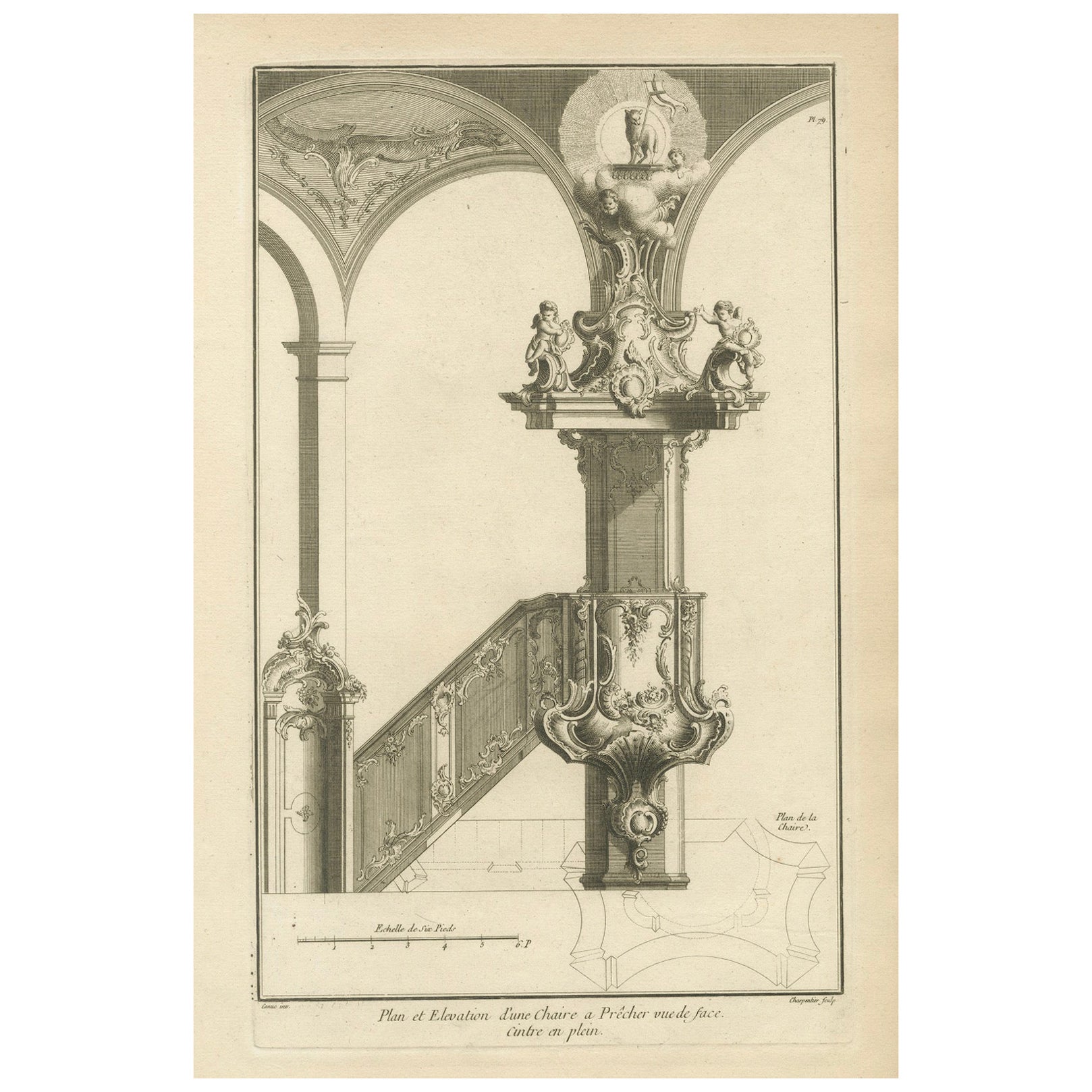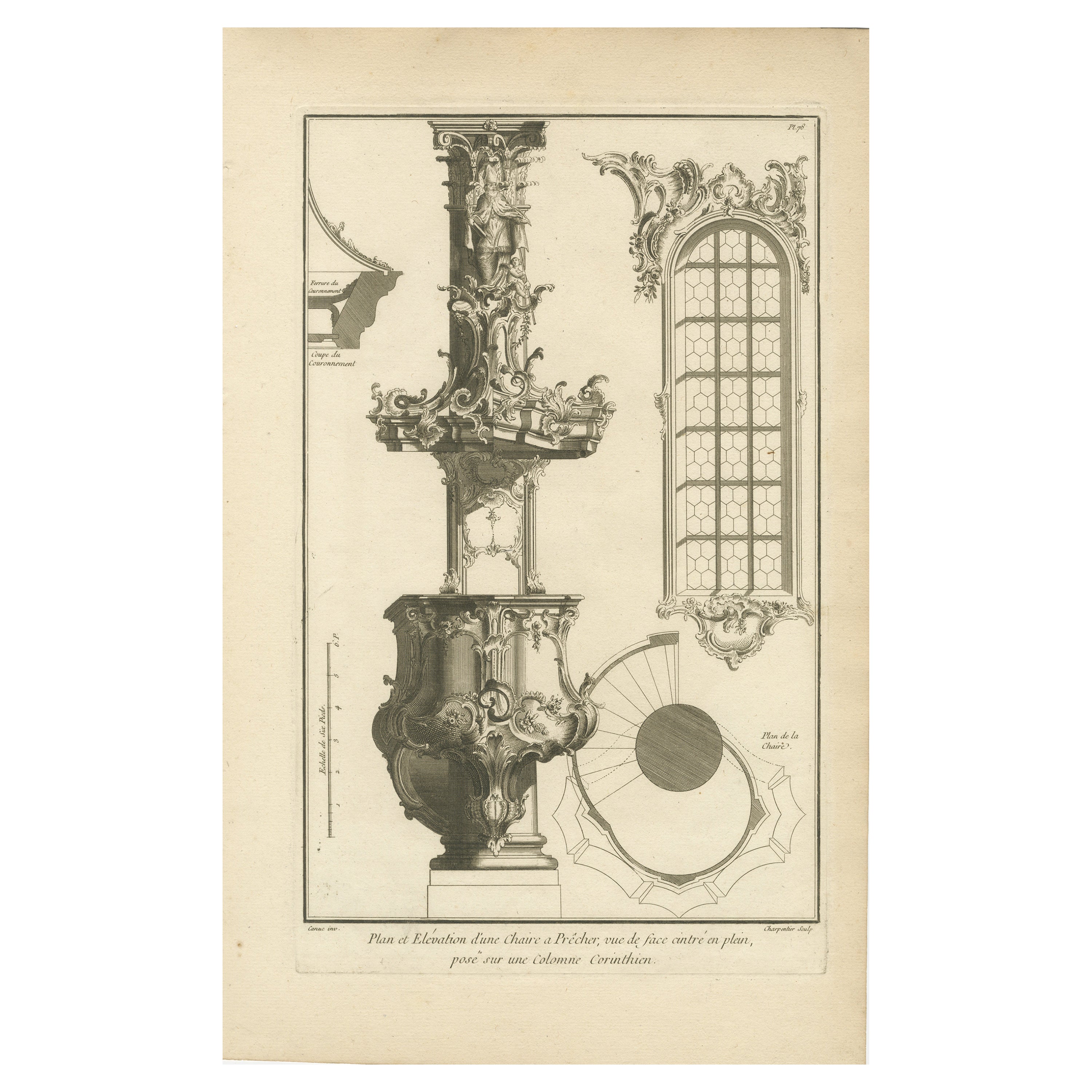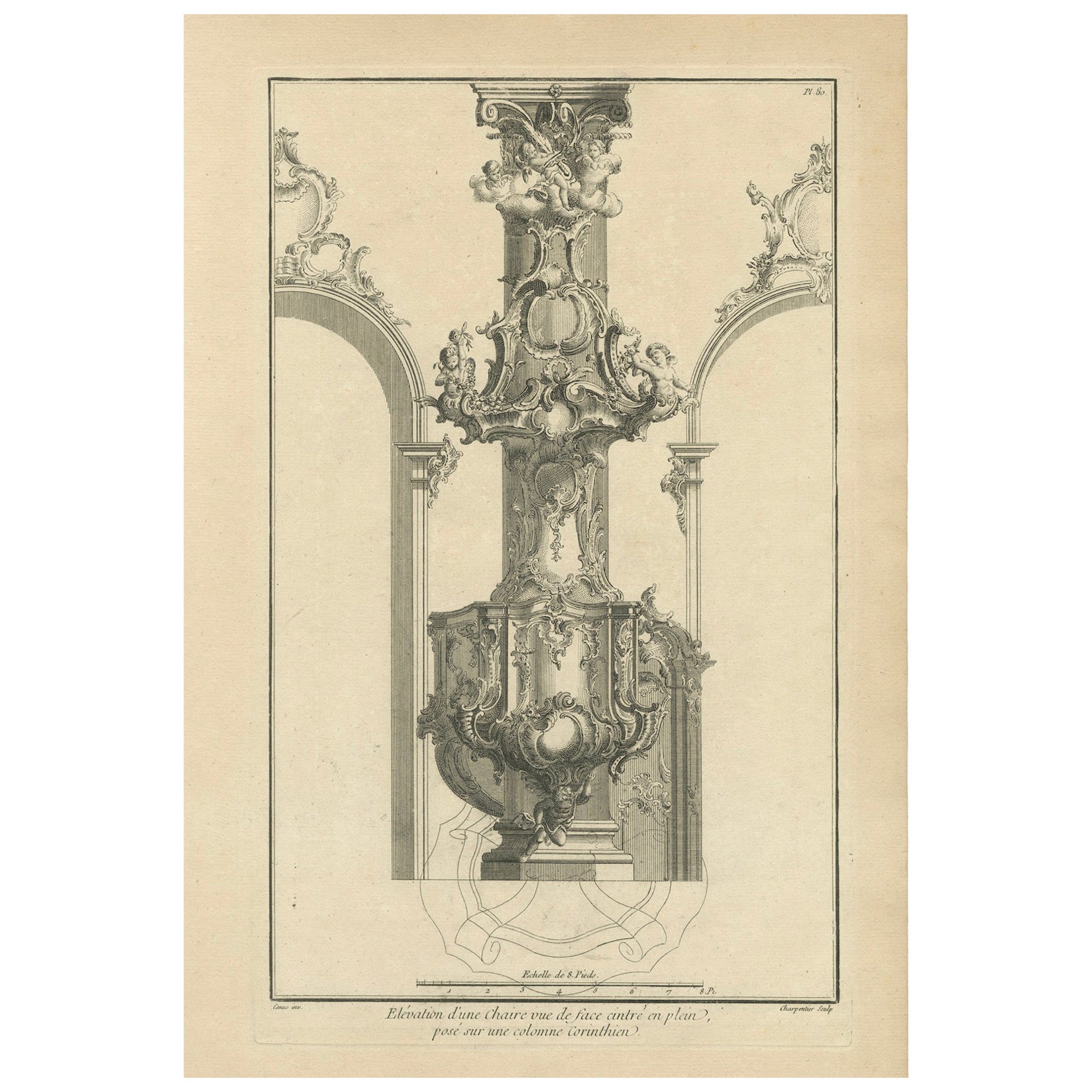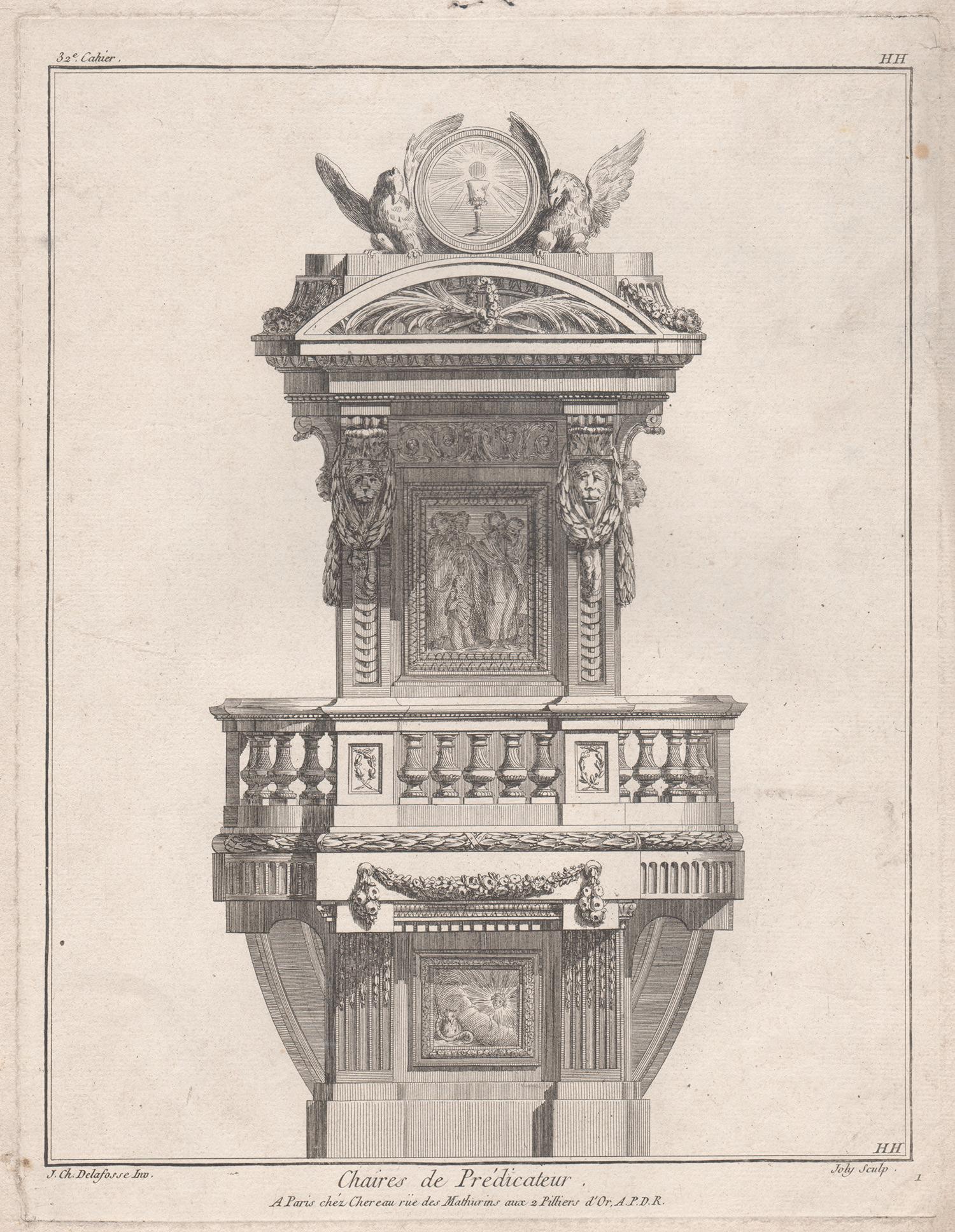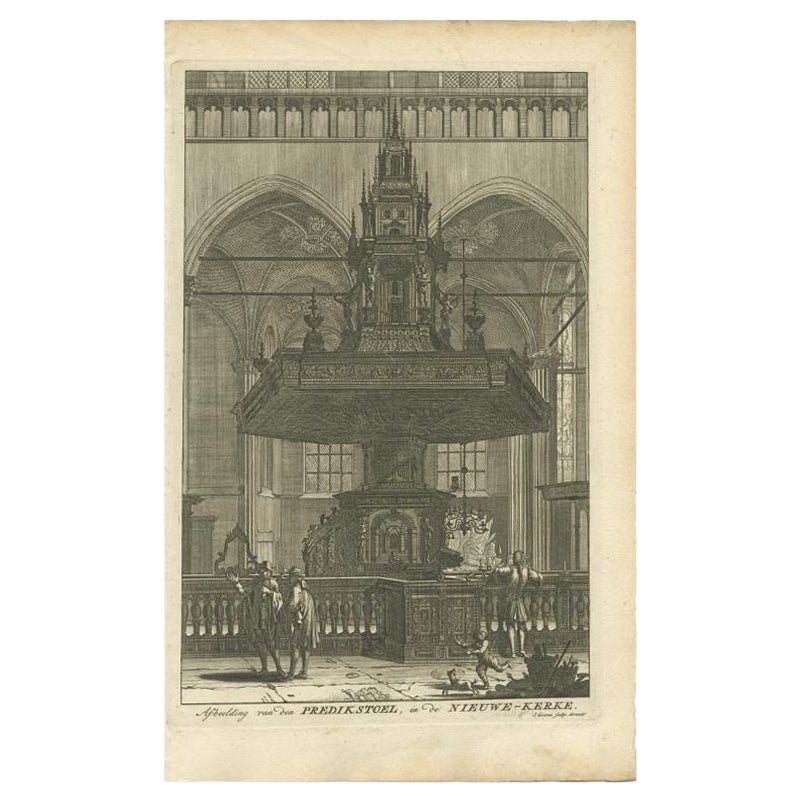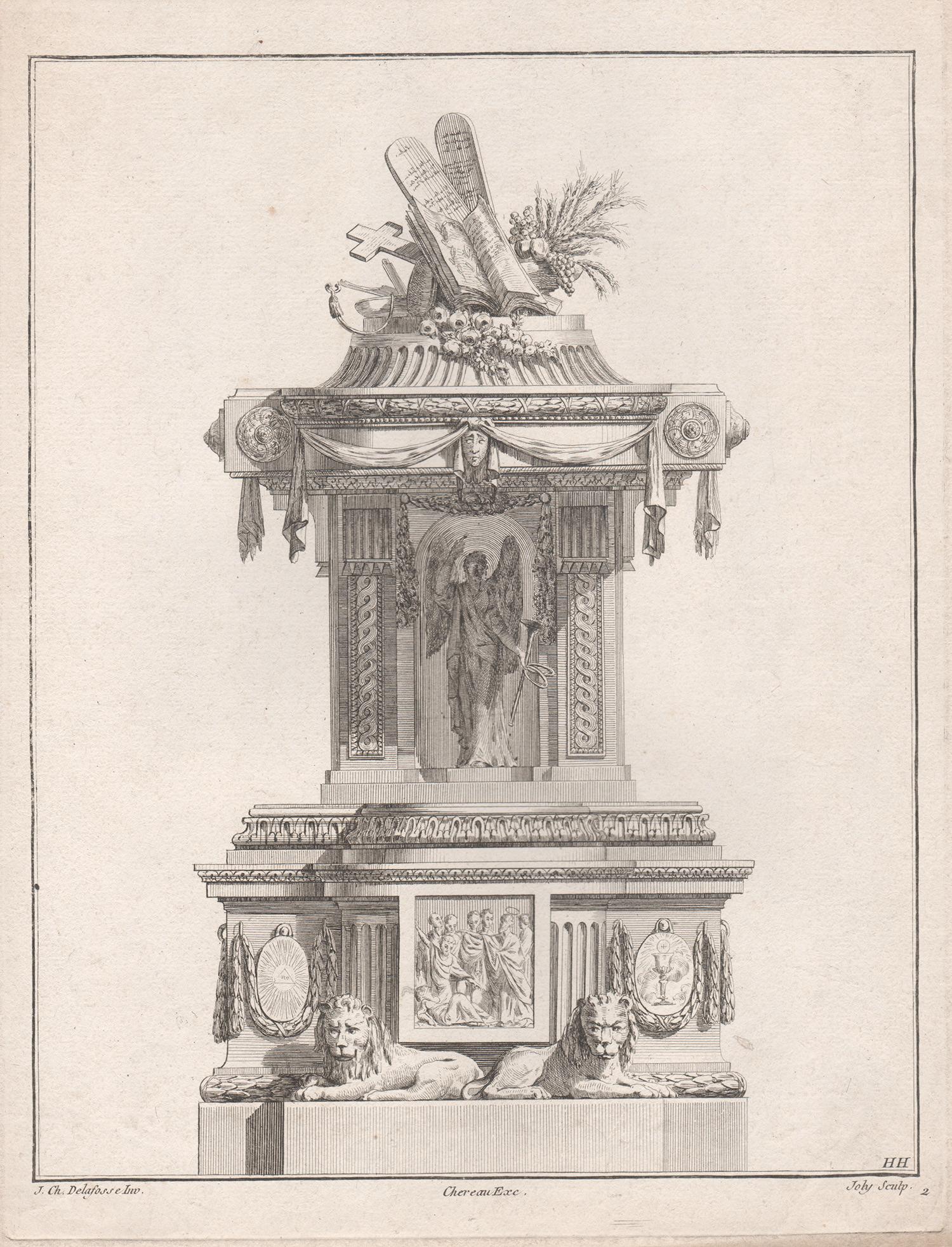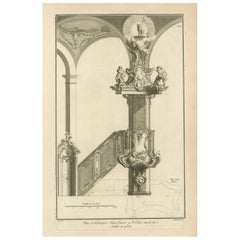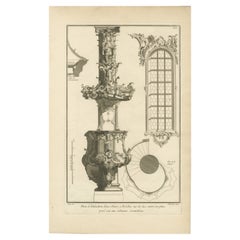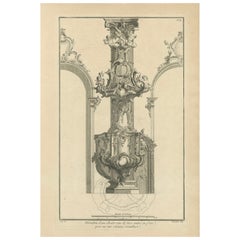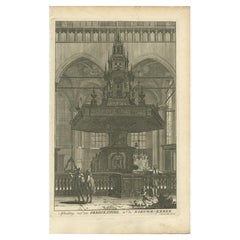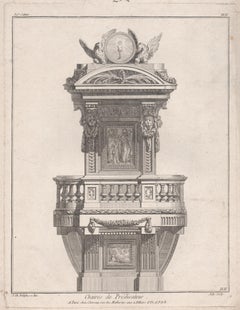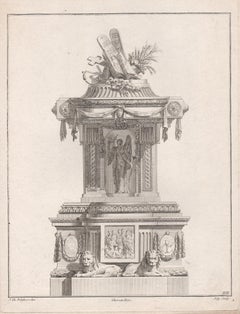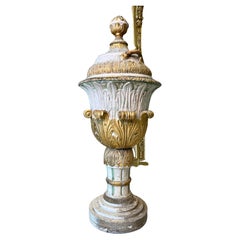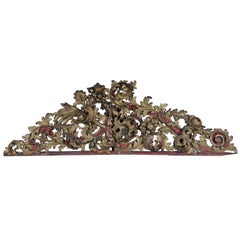Items Similar to Original Antique Baroque Sermon Pulpit with Full Arch Elevation, circa 1740
Want more images or videos?
Request additional images or videos from the seller
1 of 6
Original Antique Baroque Sermon Pulpit with Full Arch Elevation, circa 1740
$623.57
$779.4720% Off
£463.88
£579.8420% Off
€520
€65020% Off
CA$853.88
CA$1,067.3620% Off
A$949.40
A$1,186.7520% Off
CHF 495.73
CHF 619.6620% Off
MX$11,556.55
MX$14,445.6920% Off
NOK 6,325.25
NOK 7,906.5620% Off
SEK 5,926.46
SEK 7,408.0720% Off
DKK 3,958.47
DKK 4,948.0920% Off
Shipping
Retrieving quote...The 1stDibs Promise:
Authenticity Guarantee,
Money-Back Guarantee,
24-Hour Cancellation
About the Item
This is an original antique architectural design for a pulpit in baroque style dating approximately between 1740 and 1760.
The artist responsible for this design is Franz Xaver Habermann, and it was published by Johann Georg Hertel I in Augsburg. The design shows a richly decorated pulpit, typical of the Rococo style, which is known for its elaborate ornamentation, asymmetry, and curves. This image is one of four numbered plates related to this work. The detail in the engraving is meticulous, showcasing the elaborate aesthetic that characterized much of the European art and architecture during the mid-18th century.
Franz Xaver Habermann (1721–1796) was a German engraver and etcher who was active during the 18th century, a period marked by the Rococo style. Although not as widely known as some of his contemporaries, Habermann contributed significantly to the graphic arts during his time.
Habermann's work often featured architectural designs, such as the intricate pulpit depicted in the image you've provided. He was skilled in creating prints that detailed elaborate decorative schemes and architectural fantasies, which were popular during the Rococo period. His creations were known for their intricate details and the fluidity of their lines, capturing the lightness and ornamental excesses that characterized Rococo design.
Johann Georg Hertel I, who published Habermann's work, was part of a notable family of engravers and publishers in Augsburg, a city that was an important center for publishing in Europe at the time. The Hertel family played a significant role in disseminating artistic and architectural designs through their publications.
While specific details about Habermann’s life and training may not be as well-documented as those of major artists of his time, his surviving works suggest that he was a highly skilled engraver who had mastered the Rococo style, contributing to the spread of this aesthetic through his printed works. His designs would have influenced the tastes of the period, both within Germany and across Europe, where the appetite for such elaborate designs was significant.
More in detail about this engraving:
The print showcases a highly ornate pulpit in the Baroque style, viewed from the side angle. It is an architectural engraving, displaying the design in great detail. The pulpit is characterized by elaborate scrollwork, organic motifs, and dramatic curves, which are hallmarks of the Baroque period.
At the top of the pulpit, there is a decorative canopy, which includes a sculptural relief, possibly of religious significance, and is topped with what appears to be a figure of an angel. This figure adds a sense of verticality and grandeur to the structure, as it seems to watch over the proceedings from above.
The body of the pulpit itself is rich with decorative elements, including ornamental panels and a dynamic arrangement of curves and counter-curves. The pulpit is supported by a structure that includes a column or pedestal at the base, detailed with similar ornate patterns and motifs that resonate with the upper portions.
The drawing includes a side panel that might indicate the context in which the pulpit is set, suggesting the interior of a church with walls and possibly seating. Additionally, there is a ground plan to the lower part of the image, providing a bird's-eye view of the pulpit's footprint, which further aids in visualizing the spatial arrangement and the relation of the pulpit to its surroundings.
Overall, the print is a fine representation of Baroque ecclesiastical design, emphasizing drama, luxury, and movement through its complex decorative language. The craftsmanship of the engraving is meticulous, capturing the opulence and intricate designs that would have been carved into the wood or stone of the actual pulpit.
Note from seller: In our shop we also published the other three engravings in this series and they might still be on offer as well.
- Dimensions:Height: 16.54 in (42 cm)Width: 10.44 in (26.5 cm)Depth: 0 in (0.02 mm)
- Materials and Techniques:Paper,Engraved
- Period:1740-1749
- Date of Manufacture:circa 1740
- Condition:Good, given age. Light soiling near paper edges. Light staining. Left paper edges a bit rough from binding. Very light creasing from handling. General age-related toning and/or occasional minor defects from handling. Please study scan carefully.
- Seller Location:Langweer, NL
- Reference Number:Seller: BG-13675-431stDibs: LU3054338259292
About the Seller
5.0
Recognized Seller
These prestigious sellers are industry leaders and represent the highest echelon for item quality and design.
Platinum Seller
Premium sellers with a 4.7+ rating and 24-hour response times
Established in 2009
1stDibs seller since 2017
2,510 sales on 1stDibs
Typical response time: <1 hour
- ShippingRetrieving quote...Shipping from: Langweer, Netherlands
- Return Policy
Authenticity Guarantee
In the unlikely event there’s an issue with an item’s authenticity, contact us within 1 year for a full refund. DetailsMoney-Back Guarantee
If your item is not as described, is damaged in transit, or does not arrive, contact us within 7 days for a full refund. Details24-Hour Cancellation
You have a 24-hour grace period in which to reconsider your purchase, with no questions asked.Vetted Professional Sellers
Our world-class sellers must adhere to strict standards for service and quality, maintaining the integrity of our listings.Price-Match Guarantee
If you find that a seller listed the same item for a lower price elsewhere, we’ll match it.Trusted Global Delivery
Our best-in-class carrier network provides specialized shipping options worldwide, including custom delivery.More From This Seller
View AllBaroque Pulpit Elevation with Ornate Archway and Balustrade Engraved, ca.1740
Located in Langweer, NL
This is an original antique architectural design for a pulpit in baroque style with archway and balustrade dating approximately between 1740 and 1760.
The artist responsible for th...
Category
Antique 1740s Prints
Materials
Paper
$623 Sale Price
20% Off
Free Shipping
Old Baroque Pulpit Design with Corinthian Column and Staircase Plan, ca.1740
Located in Langweer, NL
Architectural design with the central elements depicted in the engraving: the Baroque design of the pulpit, the inclusion of a Corinthian column which suggests a classical influence, and the presence of a staircase plan indicating the approach to the pulpit.
Dating approximately between 1740 and 1760.
The artist responsible for this design is Franz Xaver Habermann, and it was published by Johann Georg Hertel I in Augsburg. The design shows a richly decorated pulpit and archway, typical of the Rococo style, which is known for its elaborate ornamentation, asymmetry, and curves. This image is one of four numbered plates related to this work. The detail in the engraving is meticulous, showcasing the elaborate aesthetic that characterized much of the European art and architecture during the mid-18th century.
Franz Xaver Habermann (1721–1796) was a German engraver and etcher who was active during the 18th century, a period marked by the Rococo style. Although not as widely known as some of his contemporaries, Habermann contributed significantly to the graphic arts during his time.
Habermann's work often featured architectural designs, such as the intricate pulpit depicted in the image you've provided. He was skilled in creating prints that detailed elaborate decorative schemes and architectural fantasies, which were popular during the Rococo period. His creations were known for their intricate details and the fluidity of their lines, capturing the lightness and ornamental excesses that characterized Rococo design.
Johann Georg Hertel I, who published Habermann's work, was part of a notable family of engravers and publishers in Augsburg, a city that was an important center for publishing in Europe at the time. The Hertel family played a significant role in disseminating artistic and architectural designs through their publications.
While specific details about Habermann’s life and training may not be as well-documented as those of major artists of his time, his surviving works suggest that he was a highly skilled engraver who had mastered the Rococo style, contributing to the spread of this aesthetic through his printed works. His designs would have influenced the tastes of the period, both within Germany and across Europe, where the appetite for such elaborate designs was significant.
More in detail about this engraving:
This engraving features a detailed representation of a Baroque-style preacher's pulpit, intricately designed and placed upon a Corinthian column, demonstrating the grandeur of religious architecture during the Baroque period. The pulpit is richly adorned with elaborate scrollwork, acanthus leaves, and possibly religious iconography, all common elements in Baroque ecclesiastical design.
A significant feature of this print is the inclusion of architectural details such as the Corinthian column base, known for its ornate capital with acanthus leaves and scrolls, which supports the pulpit above. This classical element signifies stability and order, providing a stark contrast to the exuberant decoration of the pulpit itself.
To the right of the pulpit, there's a tall, slender window filled with panes that could either be clear or stained glass, framed by an ornate window arch...
Category
Antique 1740s Prints
Materials
Paper
$623 Sale Price
20% Off
Free Shipping
Architectural Print of a Rococo Pulpit Elevation on a Corinthian Column, ca.1740
Located in Langweer, NL
This is an original antique architectural design for a rococo pulpit dating approximately between 1740 and 1760.
The artist responsible for this design is Franz Xaver Habermann, an...
Category
Antique 1740s Prints
Materials
Paper
$623 Sale Price
20% Off
Free Shipping
Old Print Depicting the Preacher's Pulpit of a Church in Amsterdam, 1765
Located in Langweer, NL
Antique print titled 'Afbeelding van den Predikstoel, in de Nieuwe-Kerke'. Old print depicting the preacher's pulpit of a Church in Amsterdam (Nieuwe Kerk). This print originates fro...
Category
Antique 18th Century Prints
Materials
Paper
$115 Sale Price
20% Off
Rare Antique Engraving of a Large Ornamental Bacchic Altar or Pedestal, 1740
Located in Langweer, NL
Antique print titled 'Ara, o Base con Baccanali'. Plate XXXVI:
A large, ornamental Bacchic altar or pedestal, with a relief in the centre showing a female sitting beside a reclinin...
Category
Antique 1740s Architectural Models
Materials
Paper
Antique Print of Palazzo Barberino by De Rossi, c.1710
Located in Langweer, NL
Antique print titled 'Camino nella sala del Palazzo Barberino (..)'. Old print of a fireplace in the hall of Palazzo Barberino, Rome. This print originates from 'Studio d'architettur...
Category
Antique 18th Century Prints
Materials
Paper
You May Also Like
French Neoclassical design for a Pulpit, engraving after Delafosse
Located in Melbourne, Victoria
Copper-line engraving. C1768.
Delafosse was a French decorative designer, engraver and architect. Apprenticed for a time to a sculptor, by 1767 he styled himself an 'architect and professor of design'. He published the first volume of his most important work, 'Nouvelle Iconologie Historique' in 1768, containing 110 plates of his designs for furniture, decorative arts and architectural...
Category
Late 18th Century French School Interior Prints
Materials
Engraving
French Neoclassical design for a Pulpit, engraving after Delafosse
Located in Melbourne, Victoria
Copper-line engraving. C1768.
Delafosse was a French decorative designer, engraver and architect. Apprenticed for a time to a sculptor, by 1767 he styled himself an 'architect and professor of design'. He published the first volume of his most important work, 'Nouvelle Iconologie Historique' in 1768, containing 110 plates of his designs for furniture, decorative arts and architectural...
Category
Late 18th Century French School Interior Prints
Materials
Engraving
18thC Italian baptismal font
Located in Livorno, IT
Magnificent 18thC Italian baptismal font.
Circular tank also lacquered in a soft color.
Lid blue-lacquered inside and white-lacquered outside with beautiful gilt hand carvings.
Main ...
Category
Antique Mid-18th Century Italian Baroque Religious Items
Materials
Gold Leaf
Large Baroque Supraporte / Ornamental Element, Mid-18th Century
Located in Berlin, DE
Richly carved solid wood supraporte. Gold set with red accents. Decorated plasticwood flowers and leaves. Extremely decorative and monumental. Historical condition.
(V-138)
Category
Antique Mid-18th Century French Baroque Architectural Elements
Materials
Wood
Seventeenth-Century Sermon Pulpit
Located in Cesena, FC
Portable sermon pulpit.
Seventeenth-century sermon pulpit
Constructed of poplar wood and lacquered in imitation wood.
Period: 1600s.
Measures: L. cm 91 - D. cm 76 - H. cm 134...
Category
Antique 1610s Italian Religious Items
Materials
Poplar
18th Century French Niche - Tabernacle in Walnut
Located in Round Top, TX
A wonderful 18th century French niche - tabernacle beautifully constructed from walnut. Ideal for the display of statues or santos.
Category
Antique 18th Century French Pedestals and Columns
Materials
Walnut
More Ways To Browse
Church Pulpit
Used Church Pulpit Furniture
Denmark Bronze Box
Derbyshire Marble
Distressed Antique Dresser
Dupont Silver
Dutch Cabinets 17th 18th Century
Dutch China Cabinet
Ebony Secretary
Edo Period Cabinet
Enameled Silver Box China
English Oak Bureau
English Pointer
English Samovar
Falling Clock
Flower Vase Pin
Folding Buffet
Four Post King Bed
